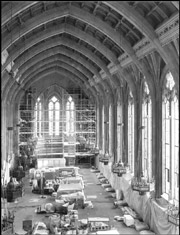The new three-story “cottages” at Saxony look weirdly comical in their Sammamish Plateau setting, like a Sasquatch prankishly slipped into a Thomas Kincaid painting. How can such spindly houses—20 feet wide and 30 feet high—mesh with the landscape of the suburban West, a traditionally wide-open place where even the churches sprawl? The very idea is outrageous.
But then so is metro Seattle’s population explosion, clotted traffic, and cost of housing. All of which is jolting some developers and architects to resurrect an ancient residential configuration, once a mainstay of dense and grimy 19th-century cities like Boston and Philadelphia, to try on for size around here. Can a three-story house work at the tip-in of the 21st century? Well, depends on who designs it. And who lives in it.
A block up the Fremont hill from Lenin’s stony scowl is Stonewater, a new development of three-story condos that could serve as a demonstration project for efficient and imaginative urban land use. A dozen dwellings are heaped onto a third of an acre, and it doesn’t feel crowded. Anyone dropping by in hopes of scoring some affordable housing, however, is likely to leave pondering whether Vladimir Ilyich was maybe right about capitalism after all.
The least expensive unit, 1,388 square feet, is $349,000 plus $190 in monthly homeowner dues. But there are compensations. The buildings are dressed in a quilt of cedar sidings and shingles stained in assorted colors, visually lightened with spidery latticework, and clustered around a multilevel courtyard with a babbling brook. The complex feels urban but looks rustic, a fine balancing act. And it slips gracefully into the neighborhood, which a three- or four-story condo box, the beast that is busily devouring next-door Ballard, would not.
“We’re just not very bright as builders and developers,” says Bill Parks, Stonewater’s developer. “I admit I balk at having to crack my mind open and look at new possibilities.”
Parks and Johnston Architects had to redesign Stonewater three times before it passed design review. The neighbors, says Parks, are convinced it was their involvement that led to the project’s success. Parks admits it was at least a good learning process for him, and he’s pleased at the attention it’s attracting. After three months, though, only three of the condos are occupied, with another three sales pending. “Consistently, I’ve heard people really like the project,” he says. “There are two points of hesitancy. One, it’s a bit of a pioneer. It’s taking time for people to realize Seattle is a high-density city. Build this in San Francisco, and it’d be a low-density project. Two, experienced developers have told me that what I did here was really foolish, that I’d have been more successful, opened the units to a wider range of buyers, if I’d built flats in a four-story box and connected them with elevators.”
But he doesn’t apologize for the stairs. “I tell ’em this is Seattle, not New York. Quit paying two thousand dollars a year for a gym membership and walk up the stairs.”
Easy to say—and do—if you’re 30, tougher if you’re 60 and contemplating a residence for the rest of your days. And it can be a drag for anyone if the house is designed to generate extra bottom-to-top commuting. A new John F. Buchan development at Issaquah Highlands stacks its bedrooms on the top floor, living areas on the main level, and below them the garage and—oh, no—laundry room.
But a three-story format has advantages, including one particularly suited to the gloomy Northwest. The typical two-story builder’s house has a hard time squeezing enough daylight into the ground floor because the garage eliminates the possibility of windows on one or more sides of the living area—and the narrower the lot and house, the darker it gets. The “cottages” at Saxony, despite their cartoon proportions, plant an open living room, kitchen, and dining room on the second floor and fill them with welcome light from windows in all directions.
Everybody’s trying to deal with ways to build housing at higher density,” says architect Greg Hackworth, who designed Saxony. “My perspective is that the three-story house builds in a sense of privacy and a better quality of light and air. I think these are things people really appreciate.”
As they spring up in the urban landscape, three-story dwellings raise several issues: some regard the interior life of the house, others the exterior life of the city.
American houses have always had a hierarchy of “public” and “private” spaces. When there’s confusion about which is which, or when the transition is too abrupt, we become uncomfortable. Ever blunder into the wrong bathroom and surprise a friend’s undies snoozing by the sink? In a two-story domicile, the division is obvious: public down, private up. With three stories, the arrangement is muddled. Which rooms are where? Who goes there?
New three-story houses are appearing in a variety of experimental arrangements. Stonewater provides living and dining on the first floor, bedrooms on the second and third. Avalon Wynhaven in Issaquah Highlands is featuring townhomes with street-level storefronts, with the proprietors living in the two floors upstairs, like watchmakers in 18th-century London. Neither makes the best possible use of views from the third floor or tries anything interesting in the stair passage, such as making it into a library. Architect Jonathan Reich, who along with his partners in the firm “Sounds Good,” designed a pair of three-story townhomes in the Mt. Baker neighborhood, configured one like this:
(3) View studio for artist/telecommuter
(2) Two bedrooms, two baths
(1) Living room, kitchen, powder room
In a dynamic and diverse city like Seattle, Reich explains, we should be creating houses like this that can adapt to a variety of living situations. And obviously, in a tight three-story house, every cubic foot must work hard, even if it means turning a stair landing into a computer hutch. But mass-market builders hate trying anything unproven; they keep reassuring each other, “Pioneers have arrows in their backs.” Buyers also turn a deep shade of conservative when picking out a home, so real innovation—rethinking the whole pattern of a house for the new century—is unlikely to come with three stories. So far, it’s just a repackaging of rooms.
Excepting Stonewater, the neighborhood patterns aren’t changing, either, which is brewing trouble. Wander through the pastel thickets of Saxony, among so many tall, tippy-looking, virtually identical, and tightly packed houses, and you begin to feel like a weevil lost in a forest of chalk. In fairness, these units were built at a much lower cost than Stonewater (rent is $1,595 per month for 1,454 square feet). But keep some math in mind: a street of dreary three-story houses is going to look 50 percent drearier than a street of dreary two-story houses. The street closes in, daylight chokes out, and the texture tilts toward more building and less landscape. If the architectural detail is intriguing and the site planning thoughtful, this may be fine. But Webster’s New Collegiate offers two definitions for “density”: 1) the quantity per unit volume, unit area, or unit length, and 2) stupidity. When the squeeze comes, American cities don’t always choose the right one.
Architect Doug Brinley, who chaired the Seattle AIA’s “Housing the Northwest” tour earlier this year, points out that the history of tract housing over the last 50 years here has steadily been shifting from horizontal to vertical. In the ’50s we built ramblers, in the ’60s split-levels, in the ’70s and ’80s came two stories, and now three. “We don’t have ‘out’ any more,” he says. “The only way to go is up. It’s been done elsewhere before. The question is how will we do it in Seattle?”







